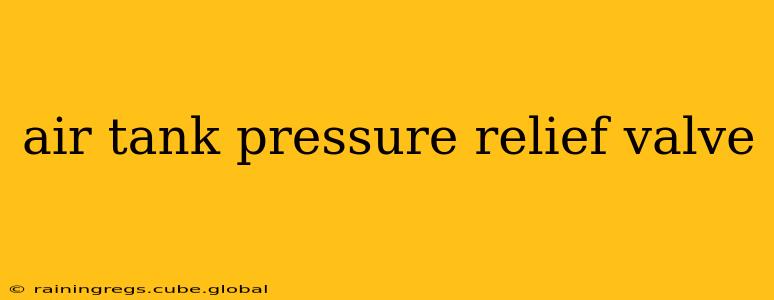Air tanks, whether used in industrial settings, automotive applications, or even scuba diving equipment, store compressed air under significant pressure. This pressure, while useful for various applications, poses a serious safety risk if not properly managed. A critical component in maintaining this safety is the air tank pressure relief valve. This valve acts as a crucial safety mechanism, preventing over-pressurization and potential catastrophic tank failure. This article will delve into the intricacies of air tank pressure relief valves, addressing common questions and concerns.
What is an Air Tank Pressure Relief Valve?
An air tank pressure relief valve, also known as a pressure relief valve (PRV), pressure safety valve (PSV), or burst disk, is a safety device designed to automatically release excess pressure from a compressed air tank when it exceeds a predetermined set point. This prevents the tank from exceeding its maximum working pressure, thus averting explosions or other dangerous failures. These valves are typically spring-loaded, meaning a spring mechanism holds the valve closed until the pressure surpasses the set limit. Once this limit is exceeded, the valve opens, releasing compressed air until the pressure drops back below the set point, then automatically reseals.
How Does an Air Tank Pressure Relief Valve Work?
The operation of an air tank pressure relief valve is relatively straightforward. The valve incorporates a spring that exerts a force against a valve seat. This force counteracts the pressure inside the tank. As long as the tank pressure remains below the predetermined set point, the spring keeps the valve firmly closed. However, when the tank pressure surpasses this limit, the force from the compressed air overcomes the spring's resistance, causing the valve to open and release the excess pressure. The valve remains open until the tank pressure reduces sufficiently for the spring to once again close the valve. Different designs use various mechanisms to achieve this, including diaphragm-operated valves and pilot-operated valves.
What are the Different Types of Air Tank Pressure Relief Valves?
Several types of air tank pressure relief valves cater to various applications and pressure ranges. These include:
- Spring-loaded valves: The most common type, relying on a spring to maintain pressure and open when exceeded.
- Pilot-operated valves: These valves use a pilot signal to control the main valve, offering more precise pressure control.
- Diaphragm-operated valves: Utilizing a flexible diaphragm to sense and respond to pressure changes.
- Rupture disks: These are not valves in the traditional sense; instead, they are designed to rupture at a specific pressure, providing a one-time release. They require replacement after activation.
How Often Should an Air Tank Pressure Relief Valve Be Tested?
Regular testing and inspection are crucial for ensuring the reliability and safety of air tank pressure relief valves. The frequency of testing varies depending on regulations, the application's criticality, and the manufacturer's recommendations. However, a minimum annual inspection and testing are generally recommended. This typically involves a visual inspection for any damage or corrosion and a pressure test to verify the valve's operation at its set point.
What Happens if an Air Tank Pressure Relief Valve Fails?
Failure of an air tank pressure relief valve can have severe consequences. If the valve fails to open when the tank pressure exceeds its maximum working pressure, the tank could over-pressurize, leading to:
- Tank rupture: A catastrophic failure resulting in the tank exploding, causing significant damage and potential injury or death.
- Leaks and escapes: A slower failure might manifest as leaks or gradual pressure escapes, leading to a loss of air pressure and potentially compromising the system's operation.
- Equipment damage: Over-pressurization can damage connected equipment and machinery.
What are the Signs of a Faulty Air Tank Pressure Relief Valve?
Regular visual inspections are crucial for early detection of potential problems. Signs of a faulty valve may include:
- Visible damage or corrosion: Look for dents, cracks, rust, or other signs of deterioration on the valve body.
- Leakage: Any leakage of compressed air around the valve indicates a potential malfunction.
- Valve sticking: If the valve seems unresponsive or difficult to operate, it might be sticking or jammed.
- Inconsistent operation: Inconsistent pressure release during testing indicates potential issues.
By understanding the critical role of air tank pressure relief valves and conducting regular maintenance and inspections, you can significantly reduce the risks associated with compressed air systems, ensuring safety and preventing catastrophic failures. Always consult the manufacturer's instructions and relevant safety regulations for specific guidance related to your particular application.
